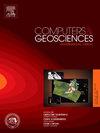Smooth slip is all you need: A singularity-free boundary element method for fault slip problems
IF 4.2
2区 地球科学
Q1 COMPUTER SCIENCE, INTERDISCIPLINARY APPLICATIONS
引用次数: 0
Abstract
Fault slip during the earthquake cycle is often spatially heterogeneous and occurs on non-planar fault surfaces. In this study, we present an analytical method for calculating displacements and stresses resulting from spatially variable fault slip on faults with arbitrary geometry in a linear elastic medium. This method enforces that fault slip is spatially continuous and differentiable, in contrast to classical constant-slip Green’s function boundary element models which suffer from stress singularities at element boundaries. By eliminating these stress singularities, our approach improves mechanical interpretability and accuracy in strain energy calculations. We demonstrate the construction and application of continuous slip boundary element models in two dimensions for the Himalayan Range Front (HRF) faults in Nepal, and show that strain energy accumulates at Pa-m/m of convergence for the greater HRF region and grows quadratically with convergence amount. The strain energy released by the 2015 Gorkha earthquake was Pa-m, equivalent to the complete release of strain energy from only m of convergence as compared to nearly uniform 6–7 m of slip estimated geodetically. The discrepancy between coseismic slip and the equivalent convergence represents a roughly 30% increase in the total strain energy in the volume over the considered interval of the earthquake cycle.
平滑滑动是你所需要的:断层滑动问题的无奇点边界元方法
地震周期中的断层滑动往往在空间上是不均匀的,并且发生在非平面的断层表面。在这项研究中,我们提出了一种计算线性弹性介质中任意几何断层上空间可变断层滑动引起的位移和应力的解析方法。与经典的常滑移格林函数边界元模型在单元边界处存在应力奇点不同,该方法使断层滑动在空间上连续且可微。通过消除这些应力奇点,我们的方法提高了应变能计算的力学可解释性和准确性。本文对尼泊尔喜马拉雅山脉前缘(HRF)断裂进行了二维连续滑动边界元模型的建立和应用,结果表明,大喜马拉雅山脉前缘区域的应变能以5.6×1013 Pa-m/m的收敛速度积累,并随收敛量的增加呈二次增长。2015年MW=7.8廓尔喀地震释放的应变能为~ 1015 Pa-m,相当于仅从~ 4 m的收敛处完全释放应变能,而与大地测量估计的几乎均匀的6-7 m滑动相比。同震滑动和等效收敛之间的差异表示在考虑的地震周期间隔内,体积中的总应变能增加了大约30%。
本文章由计算机程序翻译,如有差异,请以英文原文为准。
求助全文
约1分钟内获得全文
求助全文
来源期刊

Computers & Geosciences
地学-地球科学综合
CiteScore
9.30
自引率
6.80%
发文量
164
审稿时长
3.4 months
期刊介绍:
Computers & Geosciences publishes high impact, original research at the interface between Computer Sciences and Geosciences. Publications should apply modern computer science paradigms, whether computational or informatics-based, to address problems in the geosciences.
 求助内容:
求助内容: 应助结果提醒方式:
应助结果提醒方式:


